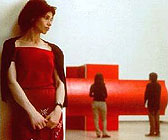|
|
|
|
H-Story
|
 |
|
A contemporaneous film I connect closely with Garrel's Sauvage innocence (2001) is Suwa Nobuhiro's H-Story, which equally challenges us to move beyond a deceptively simple arthouse film-within-a-film premise. In this case, activating a tradition that reaches from Otto e mezzo (1963) to Irma Vep (1996), what is at stake is an impossible film that, in the difficult course of its making, completely falls to pieces: a remake of Hiroshima mon amour (1959), although it is more a restaging or rereading of Duras' text than a homage to Resnais per se – and also an indirect autobiographical gesture, since Suwa (in life and in his role here as director) hails from Hiroshima. But one will be sorely disappointed if expecting from H-Story an essay on history or politics: the film starts from a kind of indifference (Hiroshima means nothing or at least little to the director-figure) and slinks down to oblivion. Like Garrel's Les Baisers de secours (1989) – or further back, Godard's Le Mépris (1963), another seminal impossible film – H-Story gazes long and hard to find an ineffable, invisible fracture between people: the moment when Béatrice Dalle (screen diva of the dawn of the twenty-first century), instinctively reacting to the incommunication of the director and his unwillingness to engage with her own interpretation of the role, decides to give up the ghost of the project and withdraw to the deepest recesses of herself. The rigour of Suwa's mise en scène and shooting strategies in conveying this subtle division and implosion of beings is breathtaking: no reverse shots whatsoever, every scene a long take from one angle, a shard of time and space with all the fine tension that ensues. As transitions between scenes – more like holes punched in the filmic fabric – Suwa employs silent inserts, colour location footage from the pre-production of Hiroshima mon amour, and moments where we are not entirely sure whether we are watching the making of the film-within or the film itself: like Garrel (in the dizzy scuttling of certainties inaugurated by the sublime sequence in Sauvage innocence set to Them's "Friday's Child"), Suwa uses the double film structure not for obvious, gratuitous shock juxtapositions of levels, but for disquieting glissandi and imbrications. Marked by that very modern, almost metaphysical sense of fundamental incommensurability and drift embodied by Tsai Ming-liang's crystalline and chilly What Time Is It There? (2001) – Suwa's cinema is one response to the project that Alain Bergala divines in Godard: "How to represent the time of an event, a feeling, an impression which might only last a fraction of a second?" (1) MORE Suwa: The Lion Sleeps Tonight © Adrian Martin March 2002 NOTE 1. Alain Bergala, Nul mieux que Godard (Paris: Cahiers du cinéma, 1999), p. 176. |
![]()